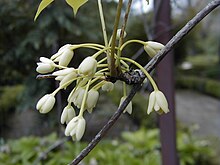| Stauntonia coriacea | |
|---|---|

| |
|
Scientific classification
| |
| Kingdom: | Plantae |
| Clade: | Tracheophytes |
| Clade: | Angiosperms |
| Clade: | Eudicots |
| Order: | Ranunculales |
| Family: | Lardizabalaceae |
| Genus: | Stauntonia |
| Species: | S. coriacea
|
| Binomial name | |
| Stauntonia coriacea (Diels) Christenh.
| |
| Synonyms [1] | |
| |
Stauntonia coriacea, commonly known as blue china vine, is an evergreen liana indigenous to temperate east Asia. The leaves have a waxy texture. It produces white monoecious flowers followed by pink-colored sausage-shaped fruits with white-colored pulp. The fruits are, technically, berries. They ripen and drop during autumn. The fruits are edible,[ citation needed] but are not commonly used as food. It is often grown as an ornamental plant.
- ^ "Stauntonia coriacea (Diels) Christenh". Plants of the World Online. Royal Botanic Gardens, Kew. 2023. Retrieved 17 March 2023.
| Stauntonia coriacea | |
|---|---|

| |
|
Scientific classification
| |
| Kingdom: | Plantae |
| Clade: | Tracheophytes |
| Clade: | Angiosperms |
| Clade: | Eudicots |
| Order: | Ranunculales |
| Family: | Lardizabalaceae |
| Genus: | Stauntonia |
| Species: | S. coriacea
|
| Binomial name | |
| Stauntonia coriacea (Diels) Christenh.
| |
| Synonyms [1] | |
| |
Stauntonia coriacea, commonly known as blue china vine, is an evergreen liana indigenous to temperate east Asia. The leaves have a waxy texture. It produces white monoecious flowers followed by pink-colored sausage-shaped fruits with white-colored pulp. The fruits are, technically, berries. They ripen and drop during autumn. The fruits are edible,[ citation needed] but are not commonly used as food. It is often grown as an ornamental plant.
- ^ "Stauntonia coriacea (Diels) Christenh". Plants of the World Online. Royal Botanic Gardens, Kew. 2023. Retrieved 17 March 2023.